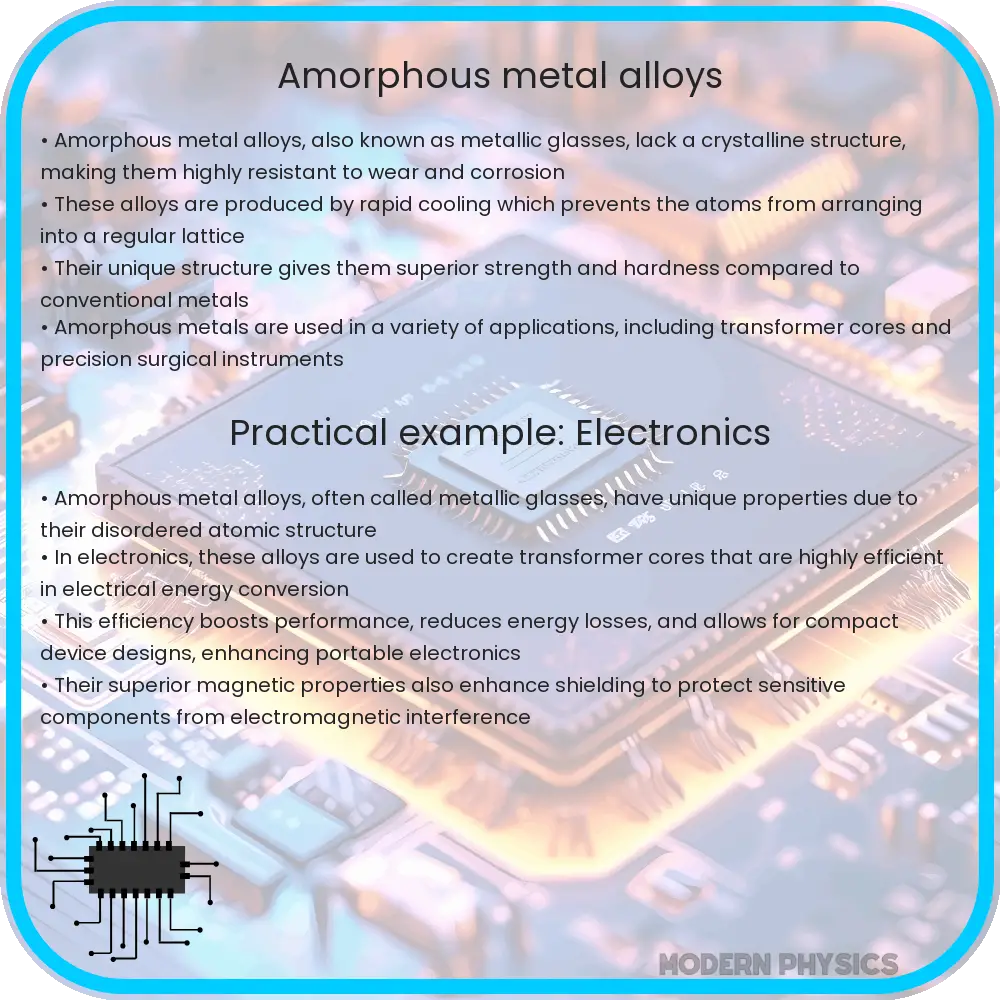Learn about amorphous metal alloys, also known as metallic glasses, and their unique properties like enhanced durability, conductivity, and flexibility.

Understanding Amorphous Metal Alloys
Amorphous metal alloys, also known as metallic glasses, are unique materials that exhibit a disordered atomic-scale structure, unlike their crystalline counterparts. This lack of long-range order, where atoms are not arranged in a regular lattice, imbues amorphous alloys with a range of intriguing and useful properties such as enhanced durability, electrical conductivity, and flexibility.
Durability of Amorphous Metal Alloys
One of the most notable properties of amorphous metal alloys is their durability. Traditional crystalline metals have grain boundaries, which are regions where the crystal structures of different grains meet. These boundaries can be weak spots where cracks initiate and propagate, leading to material failure. In contrast, the structure of amorphous metal alloys lacks these grain boundaries, providing a more uniform strength across the material. This structural uniformity results in higher resistance to wear, corrosion, and fatigue compared to crystalline metals.
Conductivity of Amorphous Metal Alloys
Amorphous metal alloys generally exhibit lower electrical conductivity than their crystalline counterparts. This characteristic can be attributed to the absence of long-range atomic order. In crystalline metals, the regular atomic arrangement allows for the easier flow of electrons, which is crucial for high electrical conductivity. However, in amorphous alloys, the disordered arrangement of atoms creates a more substantial barrier to electron movement, reducing the material’s ability to conduct electricity. This property is particularly advantageous in applications where resistance to electrical flow is desired, such as in transformer cores and other electromagnetic applications.
Flexibility of Amorphous Metal Alloys
Despite their metallic nature, some amorphous alloys can exhibit a surprising degree of flexibility. This flexibility results from their ability to endure significant bending and deformation without the initiation of cracks, a property not typically found in brittle crystalline metals. This makes amorphous metal alloys suitable for applications where materials must endure bending and shaping without failure, such as in the manufacture of precision springs and flexible electronics components.
The unique combination of durability, conductivity, and flexibility makes amorphous metal alloys a revolutionary material choice for various advanced applications in industries ranging from aerospace to consumer electronics. Understanding the foundation and characteristics of these materials can aid in further innovation and application in real-world engineering challenges.
Applications of Amorphous Metal Alloys
Amorphous metal alloys find applications in a diverse range of industries due to their unique properties. In the field of electronics, their reduced electrical conductivity makes them ideal for use in anti-theft tagging and electromagnetic shielding. The medical industry benefits from their biocompatibility and high strength-to-weight ratio, utilizing them in surgical instruments, implants, and other medical devices. Additionally, their high wear resistance and flexibility make them excellent for sporting goods such as golf clubs and baseball bats, where performance and durability are critical.
Challenges and Future Prospects
While amorphous metal alloys offer many advantages, they also pose certain challenges that need addressing for wider adoption. Their production, often through rapid cooling or other specialized techniques, can be costly and limit scalability. Further research and development are focused on developing more cost-effective and scalable manufacturing processes that could broaden their applications.
Furthermore, the understanding of long-term stability and behavior under different environmental conditions is crucial to expanding their use in critical applications like aerospace and construction. With ongoing advancements in materials science and engineering, the potential for these materials continues to grow.
Conclusion
Amorphous metal alloys, or metallic glasses, represent a significant advance in material science, providing a combination of properties not seen in traditional crystalline metals. Their unique structure—a disordered arrangement of atoms—gives rise to exceptional durability, lower electrical conductivity, and enhanced flexibility, making them suitable for a wide array of applications across various industries. While challenges in production and stability need to be overcome, the future holds great promise for these innovative materials. As we continue to explore and understand amorphous metal alloys, their potential to revolutionize the material world remains vast and inspiring, promising new solutions to engineering challenges across the globe.
